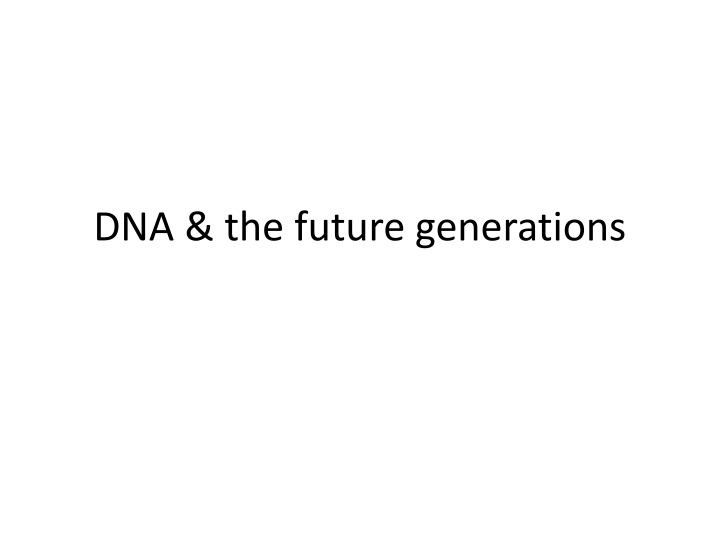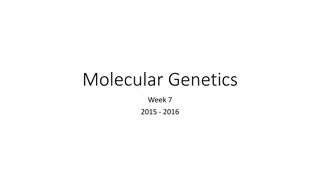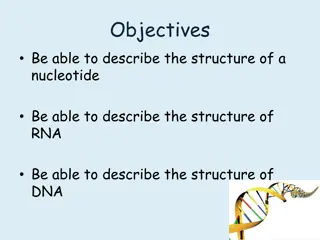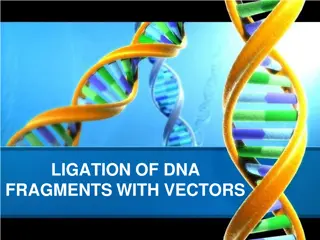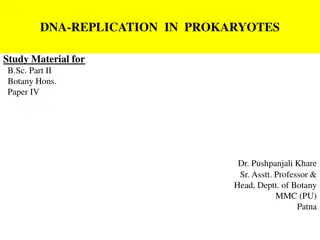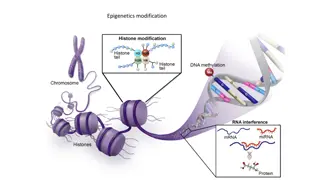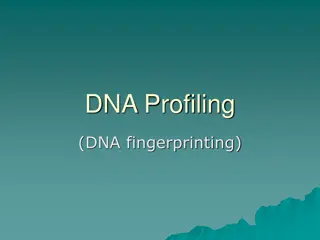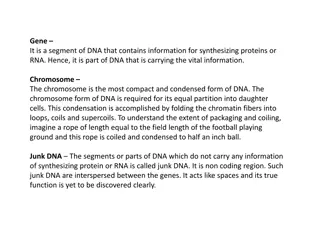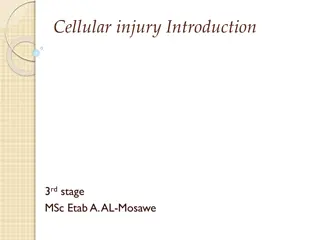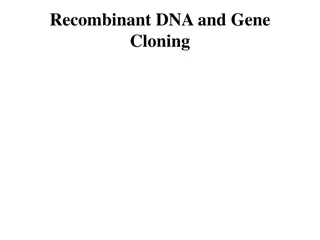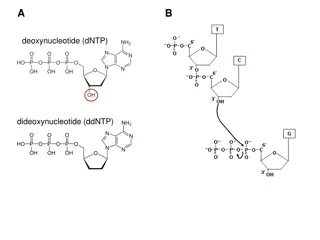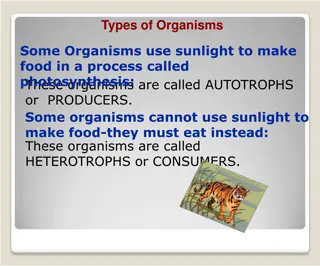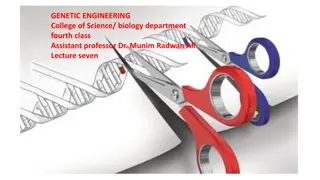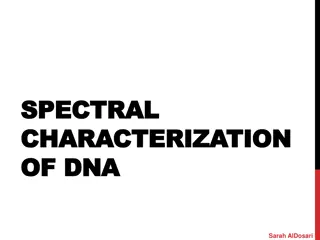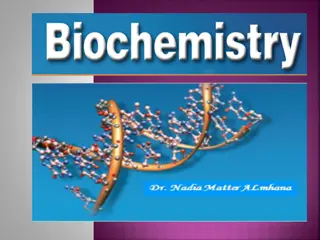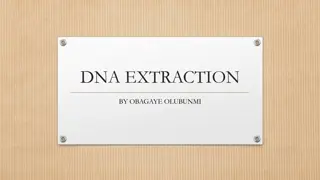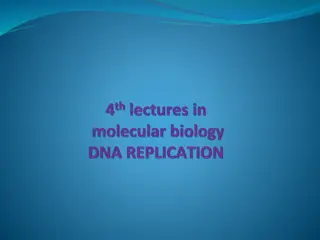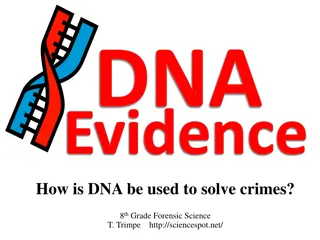The Role of DNA in Cellular Information Storage
Nucleic acids like DNA and RNA play critical roles in storing cellular information in the form of codes, enabling the formation of an organism's enzymes and structural proteins. Nucleotides, the building blocks of nucleic acids, consist of a simple sugar, a phosphate group, and a nitrogenous base. By determining the structure of proteins, DNA ultimately influences an organism's traits based on its genetic information.
Uploaded on Oct 09, 2024 | 0 Views
Download Presentation

Please find below an Image/Link to download the presentation.
The content on the website is provided AS IS for your information and personal use only. It may not be sold, licensed, or shared on other websites without obtaining consent from the author.If you encounter any issues during the download, it is possible that the publisher has removed the file from their server.
You are allowed to download the files provided on this website for personal or commercial use, subject to the condition that they are used lawfully. All files are the property of their respective owners.
The content on the website is provided AS IS for your information and personal use only. It may not be sold, licensed, or shared on other websites without obtaining consent from the author.
E N D
Presentation Transcript
The structure of nucleic acids A nucleic (noo KLAY ihk) acid is a complex biomolecule that stores cellular information in the form of a code. Nucleic acids are polymers made of smaller subunits called nucleotides. New previous New next resources
The structure of nucleic acids The information coded in DNA contains the instructions used to form all of an organism s enzymes and structural proteins. Another important nucleic acid is RNA, which stands for ribonucleic acid. RNA is a nucleic acid that forms a copy of DNA for use in making proteins. New previous New next resources
Nucleotides To return to the chapter summary click escape or close this document. New previous New TOC New next help resources
Animal Cell or Plant cell? Eukaryotic or Prokaryotic? To return to the chapter summary click escape or close this document. New previous New TOC New next resources
The structure of nucleotides #1. The simple sugar in DNA, called deoxyribose (dee ahk sih RI bos), gives DNA its name deoxyribonucleic acid. The phosphate group is composed of one atom of phosphorus surrounded by four oxygen atoms, it has a negative charge. New previous New next resources
The structure of nucleotides #2. DNA is a polymer made of repeating subunits called nucleotides. The backbone is made up of the Sugar and Phosphate group. Nitrogenous base Phosphate group Sugar (deoxyribose) Nucleotides have three parts: a simple sugar, a phosphate group, and a nitrogenous base. New previous New next resources
#2. What are the two functions DNA? Although the environment influences how an organism develops, the genetic information that is held in the molecules of DNA ultimately determines an organism s traits. DNA achieves its control by determining the structure of proteins. New previous New next resources
DNA/ RNA Beads p. 43NB Back bone= Phosphate & Sugar (Red & White) Nitrogen Bases= Adenine (Blue)=Thymine (Green) Cytosine (Yellow )=-Guanine (Orange) Uracil (Pink) RNA Hydrogen bond (clear barbell) http://learn.genetics.utah.edu/ WS - DNA Model Discussion questions
DNA Model Discussion Questions p. 43NB 1. What is the general Structure of the DNA molecule? 2. What are the 3 parts of a nucleotide? 3. Name the 2 molecules which alternate to make the sides or backbone of the DNA molecule. 4. Name the 4 nitrogen bases. 5. To which molecules does the nitrogenous base attach? 6. What are the base paring rule for DNA? 7. If there are three thymine bases on your model, how many adenine bases will there be?
DNA Model Discussion Questions 8. Draw a picture of your DNA. Label the sugar, a phosphate, and all the bases on the left and right side of the molecule you constructed. 9. If you were to open the entire DNA molecule along the hydrogen bonds and attached new bases to the sides you would have two new DNA molecules. Would these 2 DNA strands have the same base pairs? 10. Would the two DNA molecules that resulted fro replication be the exact copies of each other? Explain. Why is this important?
The structure of nucleotides A nitrogenous base is a carbon ring structure that contains one or more atoms of nitrogen. In DNA, there are four possible nitrogenous bases: adenine (A), guanine (G), cytosine (C), and thymine (T). Cytosine (C) Guanine (G) Thymine (T) Adenine (A) New previous New next resources
Learn.genetics.utah.edu Build a DNA Molecule Match the nucleotide base pair What bases always pair together? What holds the base pairs together?
Cracking the Code Answer the Questions on the sheet of paper
Protein Synthesis DNA -> transcription -> RNA -> translation -> Proteins
The Genetic Code P.292 BB The Messenger RNA Genetic Code Second Letter U C Phenylalanine (UUU) Serine (UCU) First Letter Third Letter U C A G U C A G U C A G A Tyrosine (UAU) G Cysteine (UGU) Cysteine (UGC) Stop (UGA) U Phenylalanine (UUC) Serine (UCC) Tyrosine (UAC) Serine (UCA) Serine (UCG) Stop (UAA) Stop (UAG) Leucine (UUA) Leucine (UUG) Tryptophan (UGG) Arginine (CGU) Arginine (CGC) C Leucine (CUU) Proline (CCU) Proline (CCC) Histadine (CAU) Leucine (CUC) Histadine (CAC) Proline (CCA) Arginine (CGA) Arginine (CGG) Leucine (CUA) Glutamine (CAA) Glutamine (CAG) Proline (CCG) Threonine (ACU) Leucine (CUG) Isoleucine (AUU) A Asparagine (AAU) Serine (AGU) Serine (AGC) Arginine (AGA) Arginine (AGG) Asparagine (AAC) Isoleucine (AUC) Isoleucine (AUA) Methionine; Start (AUG) Valine (GUU) Threonine (ACC) Threonine (ACA) Threonine (ACG) Lysine (AAA) Lysine (AAG) G Glycine (GGU) U C A G Alanine (GCU) Aspartate (GAU) Valine (GUC) Aspartate (GAC) Glycine (GGC) Glycine (GGC) Alanine (GCC) Alanine (GCA) Alanine (GCG) Glycine (GGA) Glycine (GGG) Glutamate (GAA) Glutamate (GAG) Valine (GUA) Valine (GUG) New previous New next resources
Genetically Modified Organisms Rice Corn Soybeans Cotton Canola
Place the following in order from smallest to largest: chromosome, nucleotide, cell, DNA, nucleus http://www.ncbi.nlm.nih.gov/Class/MLACourse/Original8Hour/Genetics/chromosome.gif
Epigenetics Ghost in your genes Video After watching this video, what are the implications of how environmental factors can alter the way your genes are expressed? HW Find other videos/ cite them and take notes. Write a summary paragraph for each one.
Works Cited Glencoe, The Dynamics of Life, McGraw-Hill Companies, Inc., 2005 NOVA PBS
